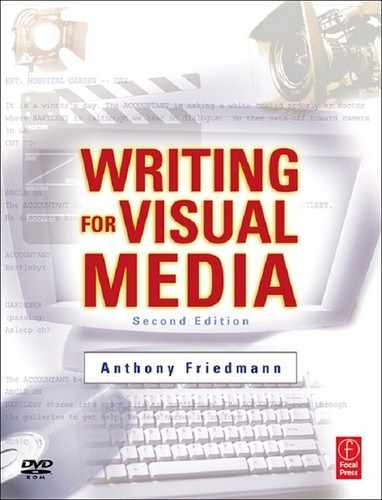Entertaining with Visual Media
Part Three
In Get Shorty (1995), John Travolta plays Chili Palmer, an enforcer for loan sharks who want to collect from a movie producer. As he gets caught up in the movie world, he comes out with the perfect line with which to launch this part of the book: “I’ve got a great idea for a movie.” Let’s face it. Everybody has an idea for a movie. We’ve all seen more films and television movies than we can count. We can all imagine a story, a character, or an imaginary world that would be just as good as some of the movies we have seen. Now is the time to look more closely at what it means to conceive and write a feature film or a long-form television script. Many dream of a concept, but not many have the perseverance to write a two-hour screenplay. Even if you can complete a screenplay, the fact is that many are written, but few are chosen. Hollywood is reputed to spend $500 million on development of stories and screenplays and buy at least 10 times more scripts than are ever produced. Most professionals would agree that there is always room for good writing and original ideas. The lure is the lucrative fees that are paid for good scripts and even for some not-so-good scripts.
The market changes constantly. Unknown writers and directors sometimes strike a chord that resonates with the public imagination and see their creation soar into the spotlight. Some low-budget movies such as The Blair Witch Project (1999) have grossed millions. In 1969, Dennis Hopper and Peter Fonda made a low-budget movie, Easy Rider, that spoke to a generation and threw Hollywood into confusion in an era when it was making big budget musicals and spectaculars that lost money. The studios at that time did not understand the youth market that made up a large portion of moviegoers. Studios usually try to back known quantities and spend the bulk of their development money on projects written by writers with demonstrable talent.
Let’s backtrack a little and look at how it all started. The companies that were making films for the arcades and nickelodeons competed fiercely. There was no talk of art. The objective was to sell the novelty of the moving picture sensation and visual amusement for profit. This meant finding ways to appeal to the general public. Within a very short time after the invention of the moving picture medium, early film makers experimented with short fictional narratives. With the first attempt to tell a story on film, a need for script writing arose. To set a camera in front of an onrushing train doesn’t require a script, but to tell the stories of the Perils of Pauline (1914) in which we see her tied to the track by a villain and wonder what will happen in next week’s episode requires storytelling. It requires a sequence of shots to be set up. Although a director might keep a simple story in his head, the economy of the medium dictates that production be planned and produced for a known cost. In order to plan and budget, there has to be a written script.
Of all the forms of film and television, the most captivating is the feature film. The power of the medium to hold audiences the world over has endured for a century. The public has embraced this experience of escapism, laughter, tears, fantasy, and drama. Talented writers and directors, in spite of the studio film factories, have made out of the medium a seventh art.1 Visual storytelling was firmly embedded in the popular culture of the 20th Century and promises to be a significant part of 21st Century media. Therefore, the writer who conceives the story or adapts the story and writes the dialogue must continue to be indispensable to program creation.
Endnote
1Andre Bazin, in Le Septième Art (New York: Penguin Books). The other 6 arts are music, drama, painting, sculpture, literature, and dance.
